| |
Merck Updated Data on Malignancies-Raltegravir
|
| |
| |
Reported by Jules Levin
Excerpted from Merck Briefing Document for FDA Hearing Sept 5, 2007
"In the original application an imbalance was observed in the rates of malignancies occurring in the Phase II and Phase III clinical development program. However, based on an updated analysis of the same study cohorts, this imbalance in number of malignancies has not been sustained with additional follow-up."
Malignancy Conclusions
• In the original application, an imbalance in rates of malignancies was noted. The malignancy types and rates in the raltegravir group are those anticipated in a
severely immunodeficient HIV/AIDS population and are consistent with reported
rates in the literature. A history of malignancy prior to enrollment was common
and many of the malignancies in the raltegravir group were likely present at time
of study entry or were recurrences of prior diagnosed malignancies.
• Based on an updated analysis of the same study cohorts, the imbalance in rates of malignancies has not been sustained with additional follow-up. This is consistent with the possibility that the original imbalance was a function of small numbers of cases and relatively imprecise estimates of rates.
• While the updated analysis is reassuring, the total amount of safety follow-up is
limited and additional data are needed. Further follow-up is proposed in the Risk
Management Plan.
".....Overall, the rates and kinds of malignancies seen in patients receiving raltegravir in the clinical development program approximate the rates and kinds of malignancies reported in the literature for patients with HIV/AIDS....
....It is also noteworthy that in the patients receiving raltegravir who ultimately developed a malignancy, the median CD4 cell count was 122 cells/mm3 and all patients with malignancy had a history of AIDS, a known independent risk factor for malignancy. Most of the malignancies encountered are associated with well known risk factors for malignancy such as AIDS, oncogenic viruses (papillomavirus infection, hepatitis B virus infection), and tobacco.
.... Rates of malignancies, along with other serious adverse events will be monitored in ongoing clinical trials, post-licensure active surveillance, and assessed in our proposed comprehensive risk management plans (see Section 9)...."
Malignancy
Overview
In the original application (data through 13-Dec-2006), in the double blind portions of the studies (Protocols 004, 005, 018, and 019), there were 10 patients (1.3%) on raltegravir and 1 patient (0.3%) on a comparator arm diagnosed with malignancies on study treatment. The patient-year adjusted rates of malignancies per 100 patient-years in the double blind portions of these studies were 1.970 in the raltegravir arms and 0.592 in the comparator groups. The apparent imbalance prompted a systematic review of malignancies overall in the safety database. The review examined all available data including double-blind and open label data from the ongoing Phase II and Phase III studies and from the Expanded Access Program.
The focus in this document is the malignancy data from the original application from the double-blind, and double-blind plus open-label portions of Protocols 004, 005, 018, and 019. Additionally, the analyses performed in the original application have been updated using cumulative data accrued during ongoing follow-up from these same studies and same patients as of 09-Jul-2007. Timing for this update was discussed with the FDA and was chosen to allow sufficient time for preparation of the updated information for the advisory committee. Per agreement with the FDA, the updated data have also been presented in this section and have been submitted to the FDA. Because these updated data were provided during review of the application the FDA has not yet reviewed these data.
In the updated cumulative dataset there were a total of 19 patients (2.5%) on raltegravir and 5 patients (1.5%) on a comparator arm diagnosed with malignancies on study treatment. The updated patient-year adjusted rates of malignancies per 100 patient-years were 2.32 in the raltegravir arms and 1.92 in the comparator groups. The apparent imbalance with respect to malignancies in the initial application appears to have not been sustained with additional follow-up. However, the sponsor plans to continue to evaluate and monitor malignancies closely; these plans are discussed in more detail in Section 9 (Risk Management Plan) of this document.
The rates and types of malignancies observed both at the time of the data cutoff for the original application as well as for the 09-Jul-2007 update are presented in more detail below. In reviewing the malignancy data, it is important to note that HIV is a risk factor for malignancy, especially in the treatment experienced patients in this application. For context, a review of the baseline medical history of the patients in the raltegravir clinical development program revealed that in patients enrolled in Protocols 004, 005, 018, and 019, 17.4% of patients in raltegravir arms and 16.4% of patients in comparator arms had been diagnosed with malignancies or pre-malignant conditions prior to enrollment. Thus
the appearance of malignancies was not unexpected in the post-enrollment period.
Double Blinded Analyses of Protocols 004, 005, 018, and 019 Included in the Original Application
As mentioned previously, in the double blind portions of Protocols 004, 005, 018, and 019, there were 10 patients (1.3%) with malignancies occurring post-randomization in participants on raltegravir and 1 patient (0.3%) with a malignancy occurring in participants on a comparator arm. The time at risk (duration of follow-up), however, for patients receiving raltegravir is not balanced compared to comparator arms because of study design. The time at risk for the raltegravir arms as of the original application for Protocols 004, 005, 018, and 019 was 508 patient-years. For the comparator arms, the time at risk was 169 patient-years.
The patient-year adjusted rates of malignancies per 100 patient-years in the double blind portions of the studies were 1.970 in the raltegravir arms and 0.592 in the comparator groups. This constitutes a Relative Risk of 3.328 (95% confidence interval 0.47, 144.45). Table 16 lists the types of malignancies seen in the double blind phase of the studies. The kinds of malignancies seen approximate the kinds of malignancies expected in heavily treatment experienced HIV patients. Patient-year adjusted rates for individual malignancy types are presented in Appendix 23.
The timing of malignancies in relationship to the initiation of ART provides information regarding malignancy in the double-bind cohort. Most (9/10) malignancies occurring in patients on raltegravir were detected within a short period after enrollment (3 months), and several showed advanced disease state at the time of diagnosis, suggesting that the malignancies were likely present, but not detected at the time of enrollment. Three (3) of
10 malignancies occurring in patients on raltegravir were recurrences of previously diagnosed malignancies (1 case of recurrent squamous cell carcinoma of the ear, 1 case of recurrent Kaposi's sarcoma, and 1 case of recurrent lymphoma), suggesting either an ongoing but undetected malignant process, or a predisposition to malignancy unrelated to study medications.
Table 16
Summary of Malignancy - Double Blind Data
Phase II and III Studies
Original Application
Figure 19 displays Kaplan-Meier estimates of time to malignancies for the double-blind phase of Protocols 004, 005, 018, and 019. Of note, no events occurred in the raltegravir arm after month 4 in this analysis.
Figure 19
Kaplan-Meier Plot of Time to Malignancy-Double-Blind Phase
Phase II and III Studies
Original Application
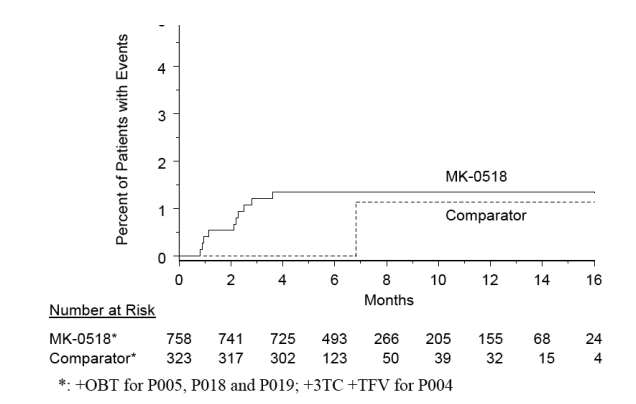
Double Blinded, Double Blind plus Open Label Analyses of Protocols 004, 005, 018, and 019, and Other Analyses Included in the Original Application
As presented in the original application, 120 patients from the comparator arms crossed over to open-label arms of the trials and received raltegravir, providing an additional 111 patient-years of follow-up in patients receiving raltegravir (total duration of follow-up on raltegravir equals 619 patient-years). During the open label phase, two (2) additional patients experienced malignancy while on open-label raltegravir; one (1) patient experienced a recurrence of Hodgkin's disease and 1 patient experienced Hodgkin's disease and basal cell carcinoma. With this additional limited follow-up, the case rate of malignancy in patients receiving raltegravir remained stable at 1.940 cases per 100 patient-years. The data from the open-label arms did not alter the conclusions regarding malignancy.
For completeness, the original application presented a listing of malignancy cases identified from a review of Worldwide Adverse Event System (WAES) reports, blinded reports from the Phase III treatment-naive study Protocol 021, and reports from the openlabel Expanded access Program. The additional review also did not alter the conclusions regarding malignancy.
Cumulative Update as of 09-Jul-2007
Note: These data have not been reviewed by the FDA.
Double Blinded Analyses of Protocols 004, 005, 018, and 019 in the Cumulative Update as of 09-Jul-2007
In the cumulative update as of 09-Jul-2007, the analyses performed in the original application were repeated with additional follow-up in the same ongoing studies and with the same patients that identified the imbalance in the original application. In the section below, all data is cumulative: all patients presented for the original application are also included in the cumulative analyses below.
As of the cumulative update, in the double blind portions of Protocols 004, 005, 018, and 019, there were 19 patients (2.5%) experiencing malignancies that occurred postrandomization in participants on raltegravir and 5 patients (1.5%) with malignancies occurring in participants on a comparator arm. The time at risk for the raltegravir arms as of the cumulative update for Protocols 004, 005, 018, and 019 was 820 patient-years. For the comparator arms, the time at risk was 261 patient-years.
As of the cumulative update, the patient-year adjusted rates of malignancies per 100 patient-years in the double blind portions of the studies are 2.32 in the raltegravir arms and 1.92 in the comparator arms. This constitutes a Relative Risk of 1.209 (95% confidence interval 0.44, 4,14). By contrast, in the original application, the Relative Risk was 3.328 (95% confidence interval 0.47,144.45).
Table 17 lists the types of malignancies seen in the double blind phase of the studies, through the cumulative update, which still approximate the kinds of malignancies expected in heavily treatment experienced patients.. Patient-year adjusted rates for individual malignancy types are presented in Appendix 24. As in the original application, many of the cancers in the raltegravir were either recurrent, or occurred within a short period (≦3 months) of enrollment.
Table 17
Summary of Malignancy - Double Blind Data
Phase II and III Studies
Cumulative Update as of 09-Jul-2007
Note: These data have not been reviewed by the FDA.
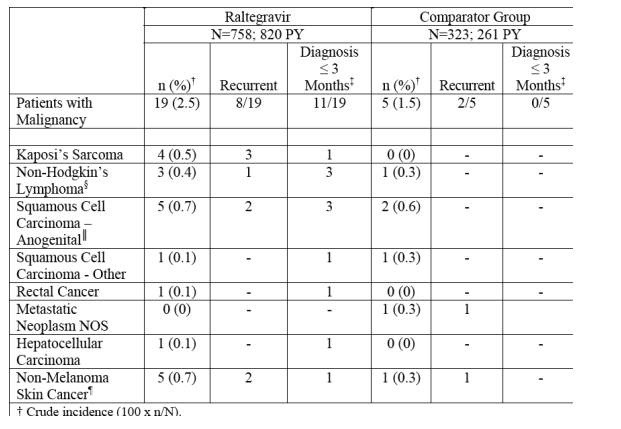
Figure 20 displays Kaplan-Meier estimates of time to malignancies for the double blind phase of Protocols 004, 005, 018 and 019 cumulatively seen over 18 months of therapy in this updated malignancy analysis.
Figure 20
Kaplan-Meier Plot of Time to Malignancy-Double-Blind Phase
Phase II and III Studies
Cumulative Update as of 09-Jul-2007
Note: These data have not been reviewed by the FDA.
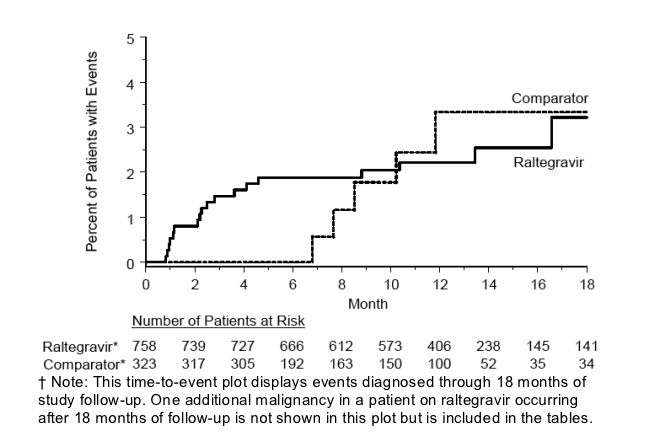
Double Blinded, and Double Blind plus Open Label Analyses of Protocols 004, 005, 018, and 019 in the Cumulative Update as of 09-Jul-2007
As in the original application, an additional analysis was done including the available follow-up from the open-label parts of these studies, using the 09-Jul-2007 visit cut-off date.
One-hundred fifty-eight (158) patients from the comparator arms crossed over to open-label arms of the trials and received raltegravir, providing an additional 298 patient-years of follow-up in patients receiving raltegravir (total duration of follow-up on raltegravir equals 1118 patient-years). Including those in both the double blind portions (presented above) and open label parts of these studies, there were 26 patients (2.8%) with 29 malignancy events in the raltegravir group including open label exposure. In the open label phase, the 8 cancers that occurred in 7 patients during the open label phase included: 1 patient with Kaposi's sarcoma, 1 patient with 2 cancers (Hodgkin's lymphoma and basal cell carcinoma), 1 patient with recurrent Hodgkin's lymphoma, 1 patient with non-Hodgkin's lymphoma in the CNS, 2 patient with squamous cell carcinoma - anogenital (1 with anal squamous cell carcinoma and 1 with anal carcinoma
in situ) and 1 patient with squamous cell carcinoma - skin that was recurrent. With this additional follow-up, the case rate of malignancy in patients receiving raltegravir remained stable at 2.32 cases per 100 patient-years.
Malignancy Discussion
It is unclear through which mechanism raltegravir could potentially increase
malignancies. As discussed in Section 4, raltegravir was not demonstrated to be
genotoxic in a battery of in vitro and in vivo assays designed to detect mutagenicity, direct DNA damage, or clastogenicity.
In the original application an imbalance was observed in the rates of malignancies occurring in the Phase II and Phase III clinical development program. However, based on an updated analysis of the same study cohorts, this imbalance in number of malignancies has not been sustained with additional follow-up.
Table 18 compares the malignancy data presented in the original application with the data obtained in the cumulative update.
Table 18
Summary of Malignancy Rates and Relative Risk
Double Blind Data
Note: The Cumulative Update data have not been reviewed by the FDA.

HIV-infected patients, and several papers reviewed included only AIDS patients. The incidence rates from these observational studies are summarized in Table 19, which displays incidence rates for cancer overall as well as for selected cancers particularly frequent in the HIV-infected population.
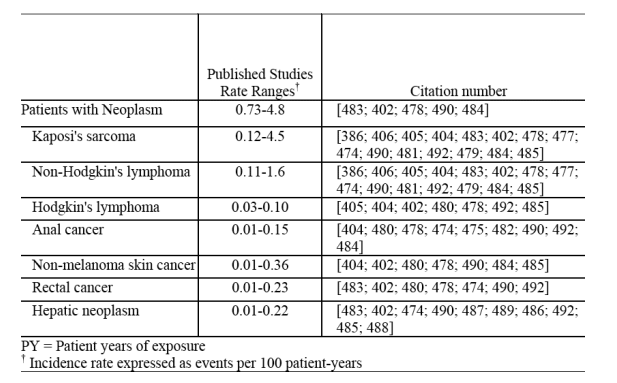
Overall, the rates and kinds of malignancies seen in patients receiving raltegravir in the clinical development program approximate the rates and kinds of malignancies reported in the literature for patients with HIV/AIDS.
It is also noteworthy that in the patients receiving raltegravir who ultimately developed a malignancy, the median CD4 cell count was 122 cells/mm3 and all patients with malignancy had a history of AIDS, a known independent risk factor for malignancy. Most of the malignancies encountered are associated with well known risk factors for malignancy such as AIDS, oncogenic viruses (papillomavirus infection, hepatitis B virus infection), and tobacco.
Rates of malignancies, along with other serious adverse events will be monitored in ongoing clinical trials, post-licensure active surveillance, and assessed in our proposed comprehensive risk management plans (see Section 9).
|
|
| |
| |
|
|
|